Marketing and Brand Management: Products vs. Brand Analysis
VerifiedAdded on 2020/06/04
|8
|2101
|56
Report
AI Summary
This report provides a detailed analysis of marketing and brand management, exploring the core concepts, models, and theories that underpin effective branding strategies. The report begins by defining marketing and brand management, emphasizing their importance in enhancing brand awareness and driving sales. It then delves into key models and theories, including Keller's brand equity model, and discusses the characteristics of branding and brand perception. The report also examines the critical difference between a brand and a product, highlighting how a brand is shaped by customer experiences and perceptions, while a product is a tangible offering. The report further explains how companies can enhance their brand image through effective marketing strategies, including promotional activities and communication. It discusses the impact of consumer choices and behaviors on brand image and the use of marketing communication to build relationships with customers. The report concludes by summarizing the key findings and emphasizing the importance of adapting to market trends and customer needs to maintain a strong brand presence. The report also discusses the importance of two-way communication with consumers to understand their requirements and the significance of consumer buying decision processes in evaluating customer behavior and product performance.

Marketing and brand
Management
Management
Paraphrase This Document
Need a fresh take? Get an instant paraphrase of this document with our AI Paraphraser

Table of Contents
INTRODUCTION...........................................................................................................................1
MODELS AND THEORIES...........................................................................................................1
CONCLUSION................................................................................................................................4
REFERENCES................................................................................................................................6
INTRODUCTION...........................................................................................................................1
MODELS AND THEORIES...........................................................................................................1
CONCLUSION................................................................................................................................4
REFERENCES................................................................................................................................6
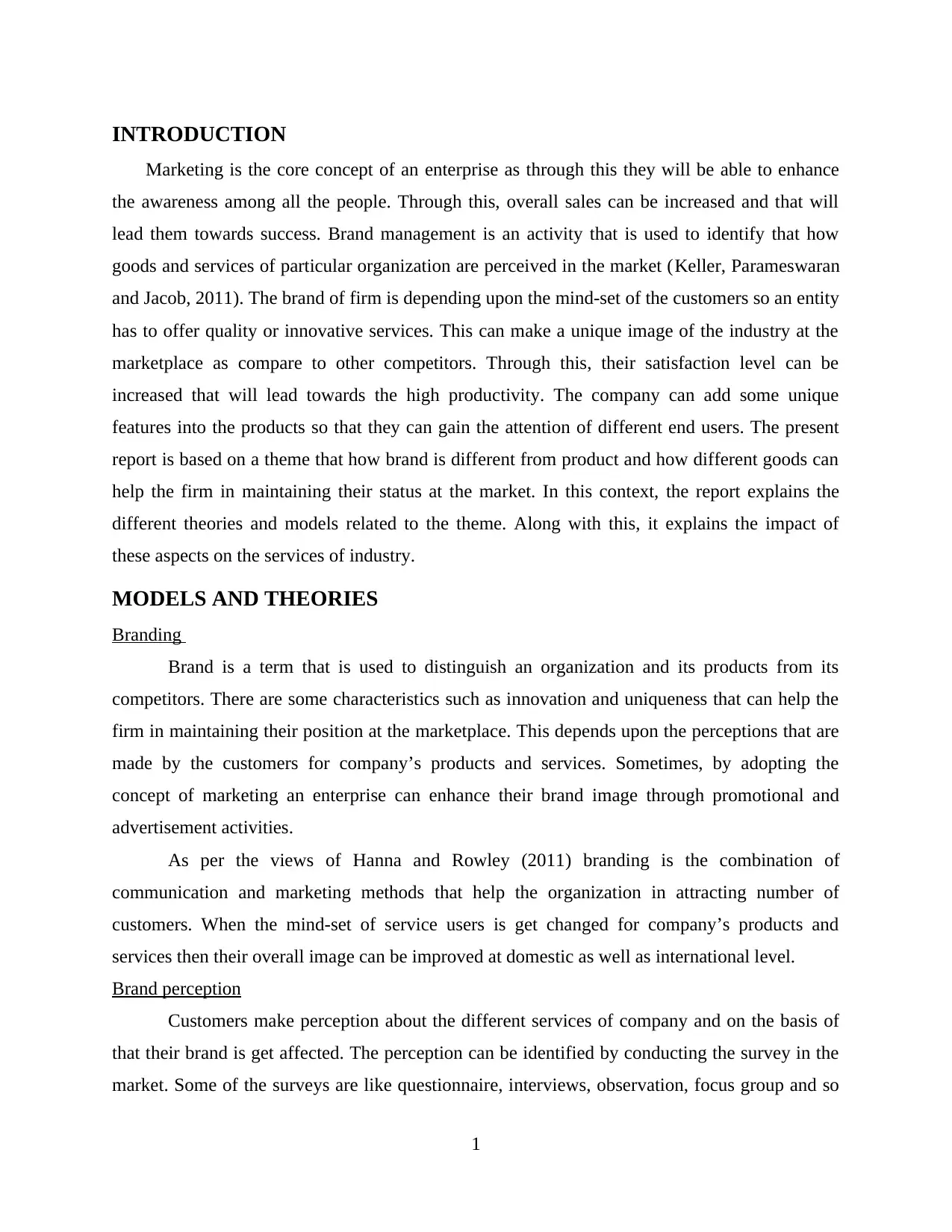
INTRODUCTION
Marketing is the core concept of an enterprise as through this they will be able to enhance
the awareness among all the people. Through this, overall sales can be increased and that will
lead them towards success. Brand management is an activity that is used to identify that how
goods and services of particular organization are perceived in the market (Keller, Parameswaran
and Jacob, 2011). The brand of firm is depending upon the mind-set of the customers so an entity
has to offer quality or innovative services. This can make a unique image of the industry at the
marketplace as compare to other competitors. Through this, their satisfaction level can be
increased that will lead towards the high productivity. The company can add some unique
features into the products so that they can gain the attention of different end users. The present
report is based on a theme that how brand is different from product and how different goods can
help the firm in maintaining their status at the market. In this context, the report explains the
different theories and models related to the theme. Along with this, it explains the impact of
these aspects on the services of industry.
MODELS AND THEORIES
Branding
Brand is a term that is used to distinguish an organization and its products from its
competitors. There are some characteristics such as innovation and uniqueness that can help the
firm in maintaining their position at the marketplace. This depends upon the perceptions that are
made by the customers for company’s products and services. Sometimes, by adopting the
concept of marketing an enterprise can enhance their brand image through promotional and
advertisement activities.
As per the views of Hanna and Rowley (2011) branding is the combination of
communication and marketing methods that help the organization in attracting number of
customers. When the mind-set of service users is get changed for company’s products and
services then their overall image can be improved at domestic as well as international level.
Brand perception
Customers make perception about the different services of company and on the basis of
that their brand is get affected. The perception can be identified by conducting the survey in the
market. Some of the surveys are like questionnaire, interviews, observation, focus group and so
1
Marketing is the core concept of an enterprise as through this they will be able to enhance
the awareness among all the people. Through this, overall sales can be increased and that will
lead them towards success. Brand management is an activity that is used to identify that how
goods and services of particular organization are perceived in the market (Keller, Parameswaran
and Jacob, 2011). The brand of firm is depending upon the mind-set of the customers so an entity
has to offer quality or innovative services. This can make a unique image of the industry at the
marketplace as compare to other competitors. Through this, their satisfaction level can be
increased that will lead towards the high productivity. The company can add some unique
features into the products so that they can gain the attention of different end users. The present
report is based on a theme that how brand is different from product and how different goods can
help the firm in maintaining their status at the market. In this context, the report explains the
different theories and models related to the theme. Along with this, it explains the impact of
these aspects on the services of industry.
MODELS AND THEORIES
Branding
Brand is a term that is used to distinguish an organization and its products from its
competitors. There are some characteristics such as innovation and uniqueness that can help the
firm in maintaining their position at the marketplace. This depends upon the perceptions that are
made by the customers for company’s products and services. Sometimes, by adopting the
concept of marketing an enterprise can enhance their brand image through promotional and
advertisement activities.
As per the views of Hanna and Rowley (2011) branding is the combination of
communication and marketing methods that help the organization in attracting number of
customers. When the mind-set of service users is get changed for company’s products and
services then their overall image can be improved at domestic as well as international level.
Brand perception
Customers make perception about the different services of company and on the basis of
that their brand is get affected. The perception can be identified by conducting the survey in the
market. Some of the surveys are like questionnaire, interviews, observation, focus group and so
1
⊘ This is a preview!⊘
Do you want full access?
Subscribe today to unlock all pages.

Trusted by 1+ million students worldwide
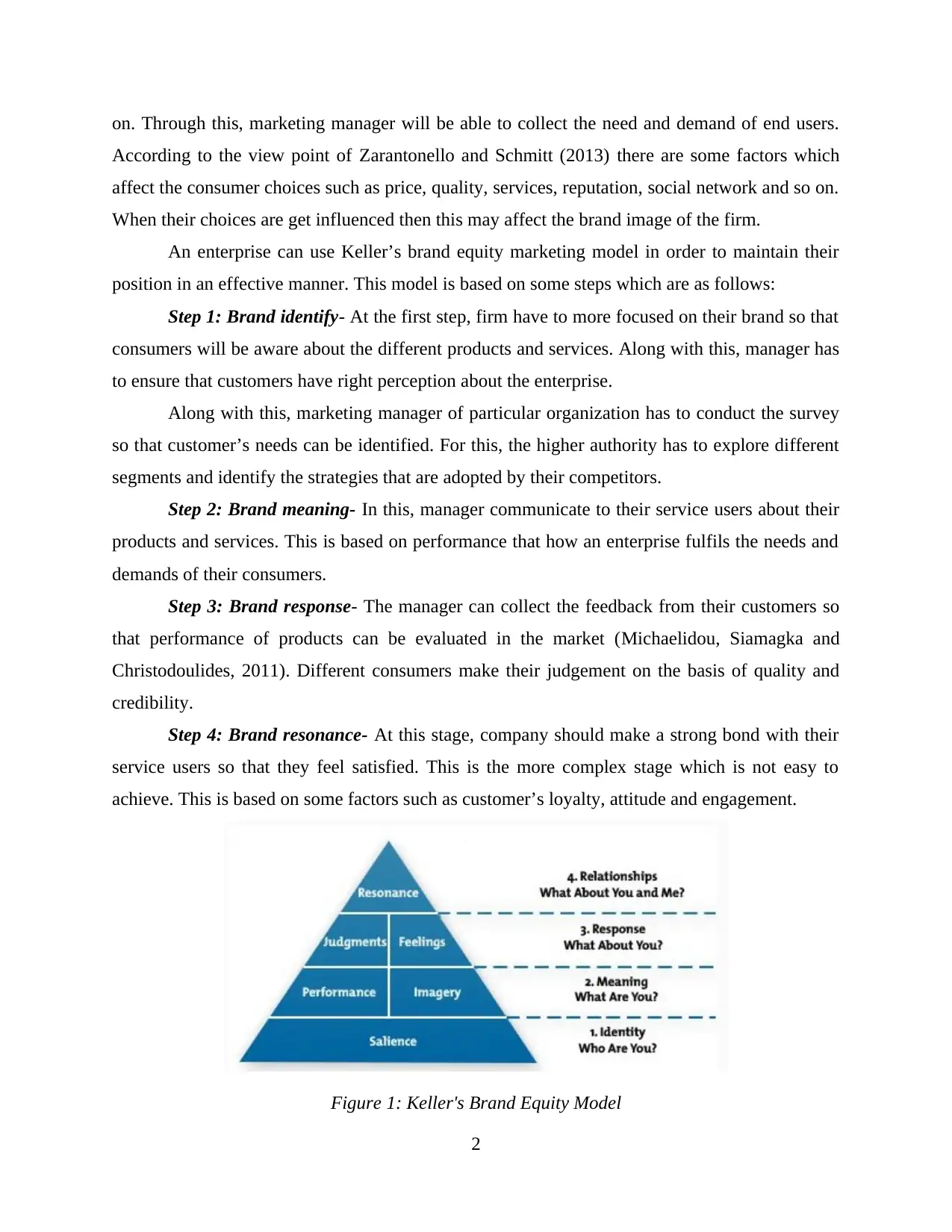
on. Through this, marketing manager will be able to collect the need and demand of end users.
According to the view point of Zarantonello and Schmitt (2013) there are some factors which
affect the consumer choices such as price, quality, services, reputation, social network and so on.
When their choices are get influenced then this may affect the brand image of the firm.
An enterprise can use Keller’s brand equity marketing model in order to maintain their
position in an effective manner. This model is based on some steps which are as follows:
Step 1: Brand identify- At the first step, firm have to more focused on their brand so that
consumers will be aware about the different products and services. Along with this, manager has
to ensure that customers have right perception about the enterprise.
Along with this, marketing manager of particular organization has to conduct the survey
so that customer’s needs can be identified. For this, the higher authority has to explore different
segments and identify the strategies that are adopted by their competitors.
Step 2: Brand meaning- In this, manager communicate to their service users about their
products and services. This is based on performance that how an enterprise fulfils the needs and
demands of their consumers.
Step 3: Brand response- The manager can collect the feedback from their customers so
that performance of products can be evaluated in the market (Michaelidou, Siamagka and
Christodoulides, 2011). Different consumers make their judgement on the basis of quality and
credibility.
Step 4: Brand resonance- At this stage, company should make a strong bond with their
service users so that they feel satisfied. This is the more complex stage which is not easy to
achieve. This is based on some factors such as customer’s loyalty, attitude and engagement.
Figure 1: Keller's Brand Equity Model
2
According to the view point of Zarantonello and Schmitt (2013) there are some factors which
affect the consumer choices such as price, quality, services, reputation, social network and so on.
When their choices are get influenced then this may affect the brand image of the firm.
An enterprise can use Keller’s brand equity marketing model in order to maintain their
position in an effective manner. This model is based on some steps which are as follows:
Step 1: Brand identify- At the first step, firm have to more focused on their brand so that
consumers will be aware about the different products and services. Along with this, manager has
to ensure that customers have right perception about the enterprise.
Along with this, marketing manager of particular organization has to conduct the survey
so that customer’s needs can be identified. For this, the higher authority has to explore different
segments and identify the strategies that are adopted by their competitors.
Step 2: Brand meaning- In this, manager communicate to their service users about their
products and services. This is based on performance that how an enterprise fulfils the needs and
demands of their consumers.
Step 3: Brand response- The manager can collect the feedback from their customers so
that performance of products can be evaluated in the market (Michaelidou, Siamagka and
Christodoulides, 2011). Different consumers make their judgement on the basis of quality and
credibility.
Step 4: Brand resonance- At this stage, company should make a strong bond with their
service users so that they feel satisfied. This is the more complex stage which is not easy to
achieve. This is based on some factors such as customer’s loyalty, attitude and engagement.
Figure 1: Keller's Brand Equity Model
2
Paraphrase This Document
Need a fresh take? Get an instant paraphrase of this document with our AI Paraphraser
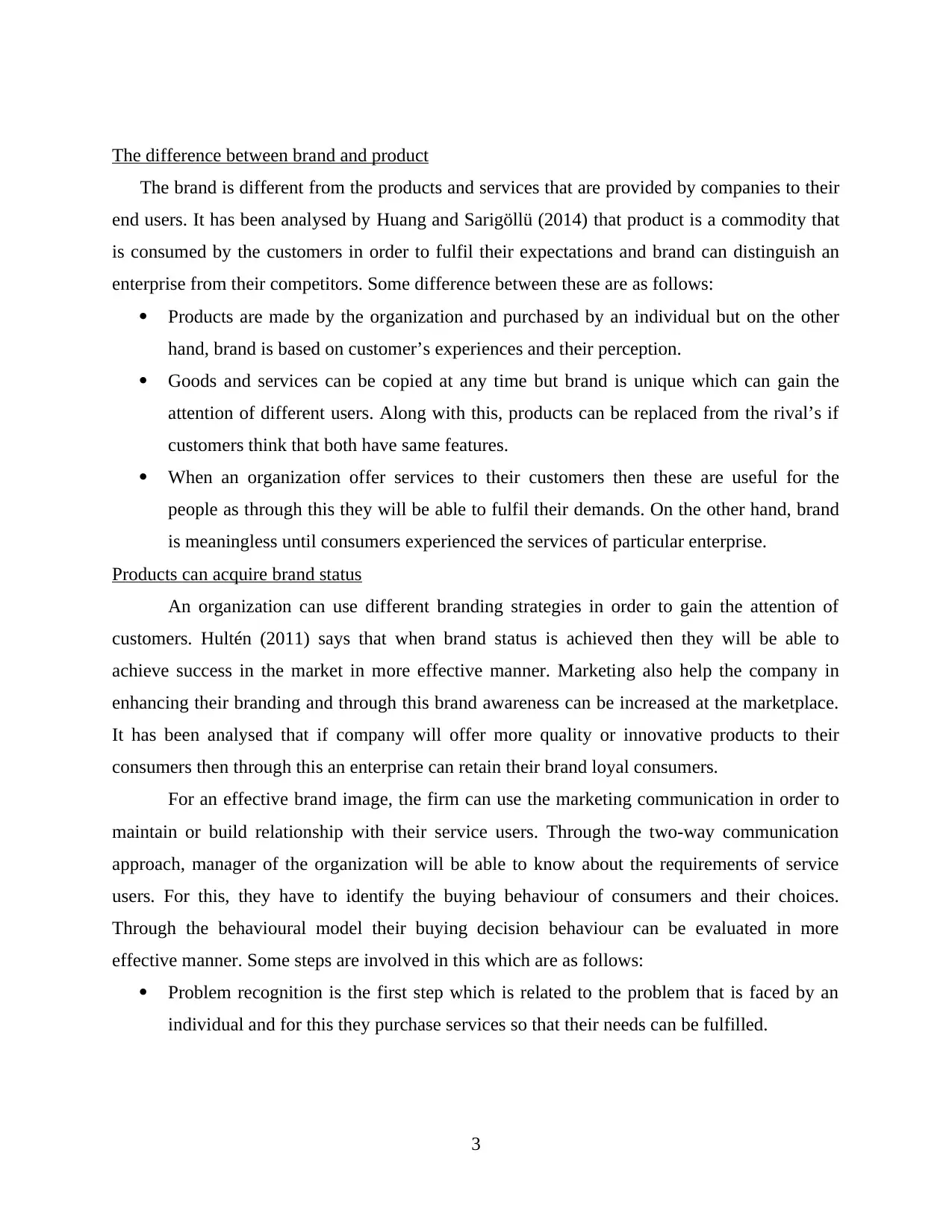
The difference between brand and product
The brand is different from the products and services that are provided by companies to their
end users. It has been analysed by Huang and Sarigöllü (2014) that product is a commodity that
is consumed by the customers in order to fulfil their expectations and brand can distinguish an
enterprise from their competitors. Some difference between these are as follows:
Products are made by the organization and purchased by an individual but on the other
hand, brand is based on customer’s experiences and their perception.
Goods and services can be copied at any time but brand is unique which can gain the
attention of different users. Along with this, products can be replaced from the rival’s if
customers think that both have same features.
When an organization offer services to their customers then these are useful for the
people as through this they will be able to fulfil their demands. On the other hand, brand
is meaningless until consumers experienced the services of particular enterprise.
Products can acquire brand status
An organization can use different branding strategies in order to gain the attention of
customers. Hultén (2011) says that when brand status is achieved then they will be able to
achieve success in the market in more effective manner. Marketing also help the company in
enhancing their branding and through this brand awareness can be increased at the marketplace.
It has been analysed that if company will offer more quality or innovative products to their
consumers then through this an enterprise can retain their brand loyal consumers.
For an effective brand image, the firm can use the marketing communication in order to
maintain or build relationship with their service users. Through the two-way communication
approach, manager of the organization will be able to know about the requirements of service
users. For this, they have to identify the buying behaviour of consumers and their choices.
Through the behavioural model their buying decision behaviour can be evaluated in more
effective manner. Some steps are involved in this which are as follows:
Problem recognition is the first step which is related to the problem that is faced by an
individual and for this they purchase services so that their needs can be fulfilled.
3
The brand is different from the products and services that are provided by companies to their
end users. It has been analysed by Huang and Sarigöllü (2014) that product is a commodity that
is consumed by the customers in order to fulfil their expectations and brand can distinguish an
enterprise from their competitors. Some difference between these are as follows:
Products are made by the organization and purchased by an individual but on the other
hand, brand is based on customer’s experiences and their perception.
Goods and services can be copied at any time but brand is unique which can gain the
attention of different users. Along with this, products can be replaced from the rival’s if
customers think that both have same features.
When an organization offer services to their customers then these are useful for the
people as through this they will be able to fulfil their demands. On the other hand, brand
is meaningless until consumers experienced the services of particular enterprise.
Products can acquire brand status
An organization can use different branding strategies in order to gain the attention of
customers. Hultén (2011) says that when brand status is achieved then they will be able to
achieve success in the market in more effective manner. Marketing also help the company in
enhancing their branding and through this brand awareness can be increased at the marketplace.
It has been analysed that if company will offer more quality or innovative products to their
consumers then through this an enterprise can retain their brand loyal consumers.
For an effective brand image, the firm can use the marketing communication in order to
maintain or build relationship with their service users. Through the two-way communication
approach, manager of the organization will be able to know about the requirements of service
users. For this, they have to identify the buying behaviour of consumers and their choices.
Through the behavioural model their buying decision behaviour can be evaluated in more
effective manner. Some steps are involved in this which are as follows:
Problem recognition is the first step which is related to the problem that is faced by an
individual and for this they purchase services so that their needs can be fulfilled.
3
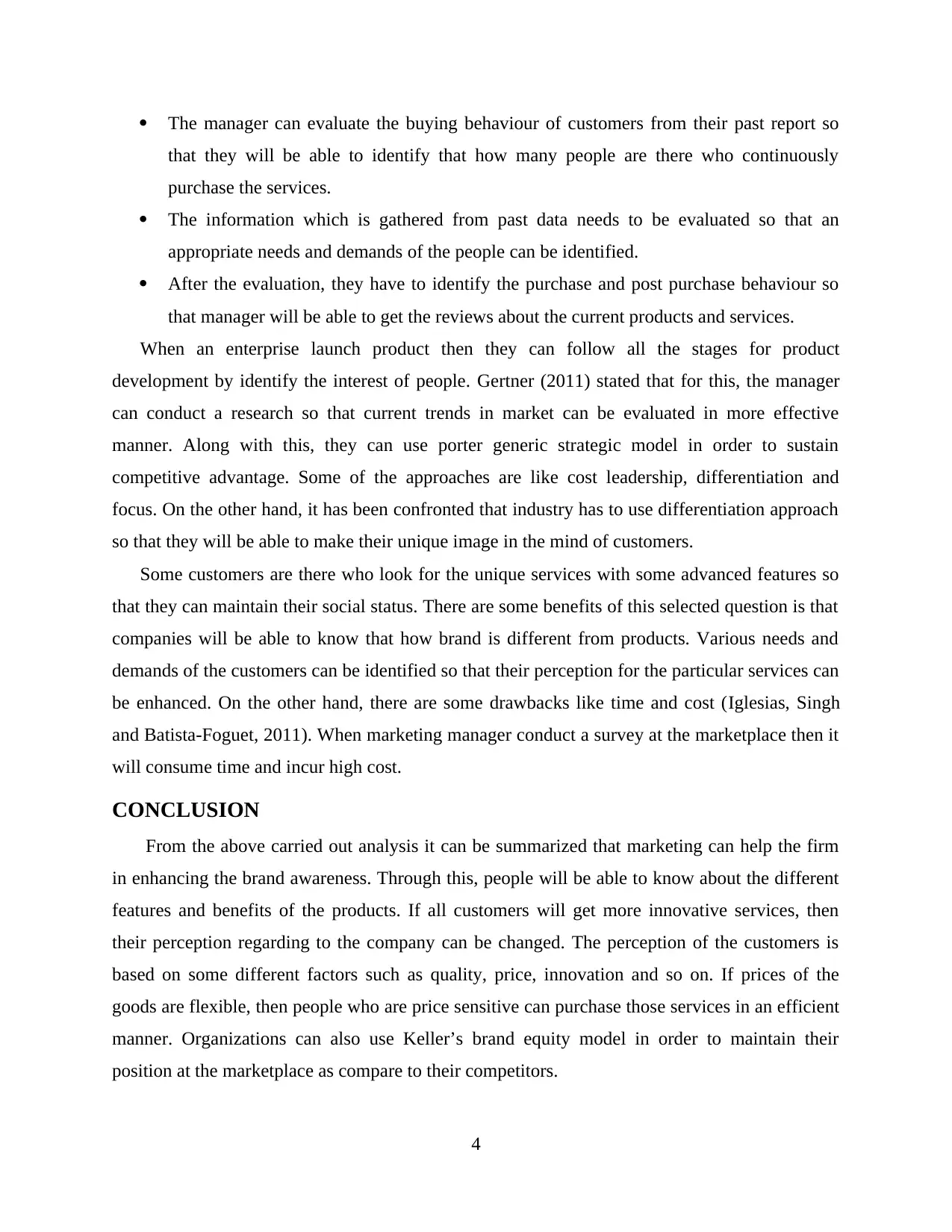
The manager can evaluate the buying behaviour of customers from their past report so
that they will be able to identify that how many people are there who continuously
purchase the services.
The information which is gathered from past data needs to be evaluated so that an
appropriate needs and demands of the people can be identified.
After the evaluation, they have to identify the purchase and post purchase behaviour so
that manager will be able to get the reviews about the current products and services.
When an enterprise launch product then they can follow all the stages for product
development by identify the interest of people. Gertner (2011) stated that for this, the manager
can conduct a research so that current trends in market can be evaluated in more effective
manner. Along with this, they can use porter generic strategic model in order to sustain
competitive advantage. Some of the approaches are like cost leadership, differentiation and
focus. On the other hand, it has been confronted that industry has to use differentiation approach
so that they will be able to make their unique image in the mind of customers.
Some customers are there who look for the unique services with some advanced features so
that they can maintain their social status. There are some benefits of this selected question is that
companies will be able to know that how brand is different from products. Various needs and
demands of the customers can be identified so that their perception for the particular services can
be enhanced. On the other hand, there are some drawbacks like time and cost (Iglesias, Singh
and Batista-Foguet, 2011). When marketing manager conduct a survey at the marketplace then it
will consume time and incur high cost.
CONCLUSION
From the above carried out analysis it can be summarized that marketing can help the firm
in enhancing the brand awareness. Through this, people will be able to know about the different
features and benefits of the products. If all customers will get more innovative services, then
their perception regarding to the company can be changed. The perception of the customers is
based on some different factors such as quality, price, innovation and so on. If prices of the
goods are flexible, then people who are price sensitive can purchase those services in an efficient
manner. Organizations can also use Keller’s brand equity model in order to maintain their
position at the marketplace as compare to their competitors.
4
that they will be able to identify that how many people are there who continuously
purchase the services.
The information which is gathered from past data needs to be evaluated so that an
appropriate needs and demands of the people can be identified.
After the evaluation, they have to identify the purchase and post purchase behaviour so
that manager will be able to get the reviews about the current products and services.
When an enterprise launch product then they can follow all the stages for product
development by identify the interest of people. Gertner (2011) stated that for this, the manager
can conduct a research so that current trends in market can be evaluated in more effective
manner. Along with this, they can use porter generic strategic model in order to sustain
competitive advantage. Some of the approaches are like cost leadership, differentiation and
focus. On the other hand, it has been confronted that industry has to use differentiation approach
so that they will be able to make their unique image in the mind of customers.
Some customers are there who look for the unique services with some advanced features so
that they can maintain their social status. There are some benefits of this selected question is that
companies will be able to know that how brand is different from products. Various needs and
demands of the customers can be identified so that their perception for the particular services can
be enhanced. On the other hand, there are some drawbacks like time and cost (Iglesias, Singh
and Batista-Foguet, 2011). When marketing manager conduct a survey at the marketplace then it
will consume time and incur high cost.
CONCLUSION
From the above carried out analysis it can be summarized that marketing can help the firm
in enhancing the brand awareness. Through this, people will be able to know about the different
features and benefits of the products. If all customers will get more innovative services, then
their perception regarding to the company can be changed. The perception of the customers is
based on some different factors such as quality, price, innovation and so on. If prices of the
goods are flexible, then people who are price sensitive can purchase those services in an efficient
manner. Organizations can also use Keller’s brand equity model in order to maintain their
position at the marketplace as compare to their competitors.
4
⊘ This is a preview!⊘
Do you want full access?
Subscribe today to unlock all pages.

Trusted by 1+ million students worldwide
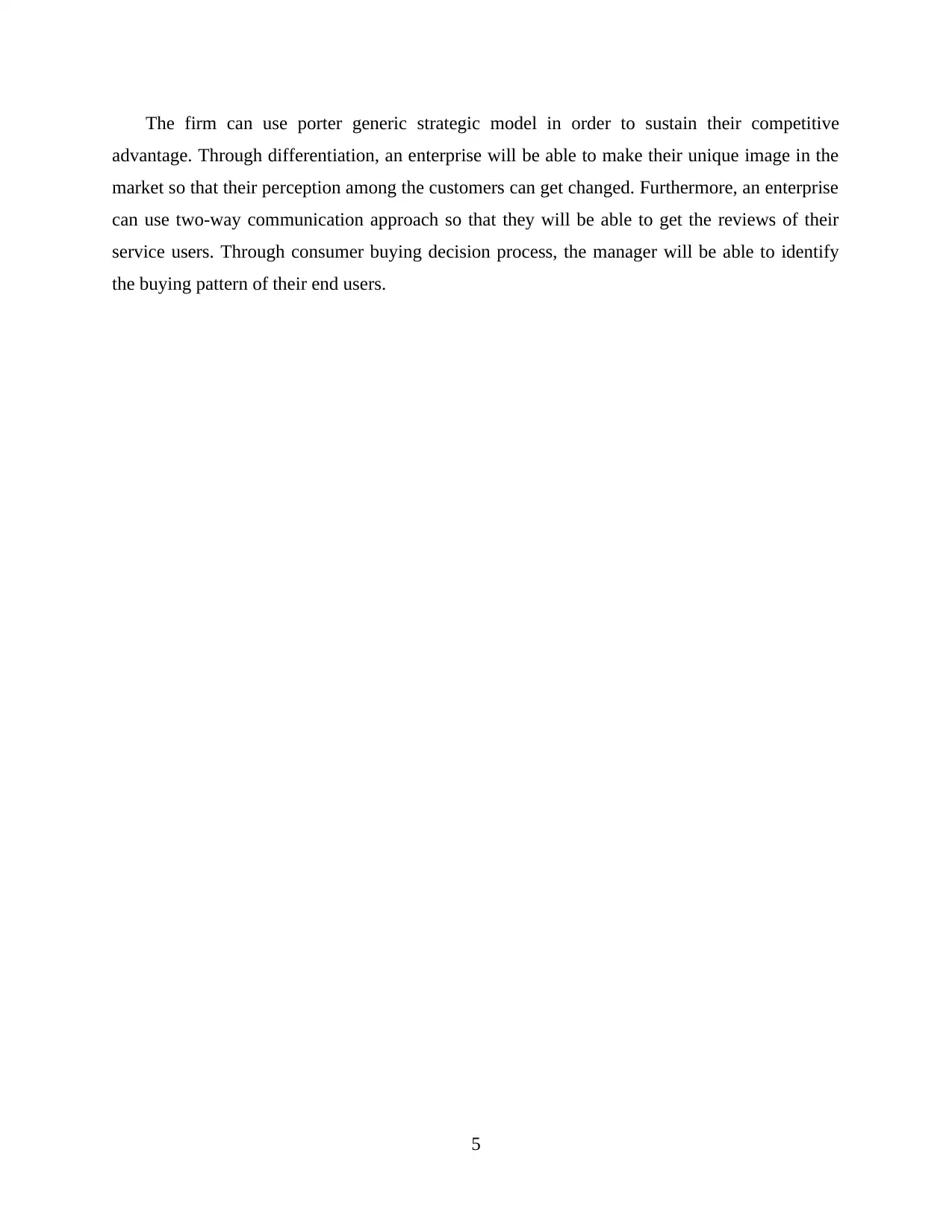
The firm can use porter generic strategic model in order to sustain their competitive
advantage. Through differentiation, an enterprise will be able to make their unique image in the
market so that their perception among the customers can get changed. Furthermore, an enterprise
can use two-way communication approach so that they will be able to get the reviews of their
service users. Through consumer buying decision process, the manager will be able to identify
the buying pattern of their end users.
5
advantage. Through differentiation, an enterprise will be able to make their unique image in the
market so that their perception among the customers can get changed. Furthermore, an enterprise
can use two-way communication approach so that they will be able to get the reviews of their
service users. Through consumer buying decision process, the manager will be able to identify
the buying pattern of their end users.
5
Paraphrase This Document
Need a fresh take? Get an instant paraphrase of this document with our AI Paraphraser
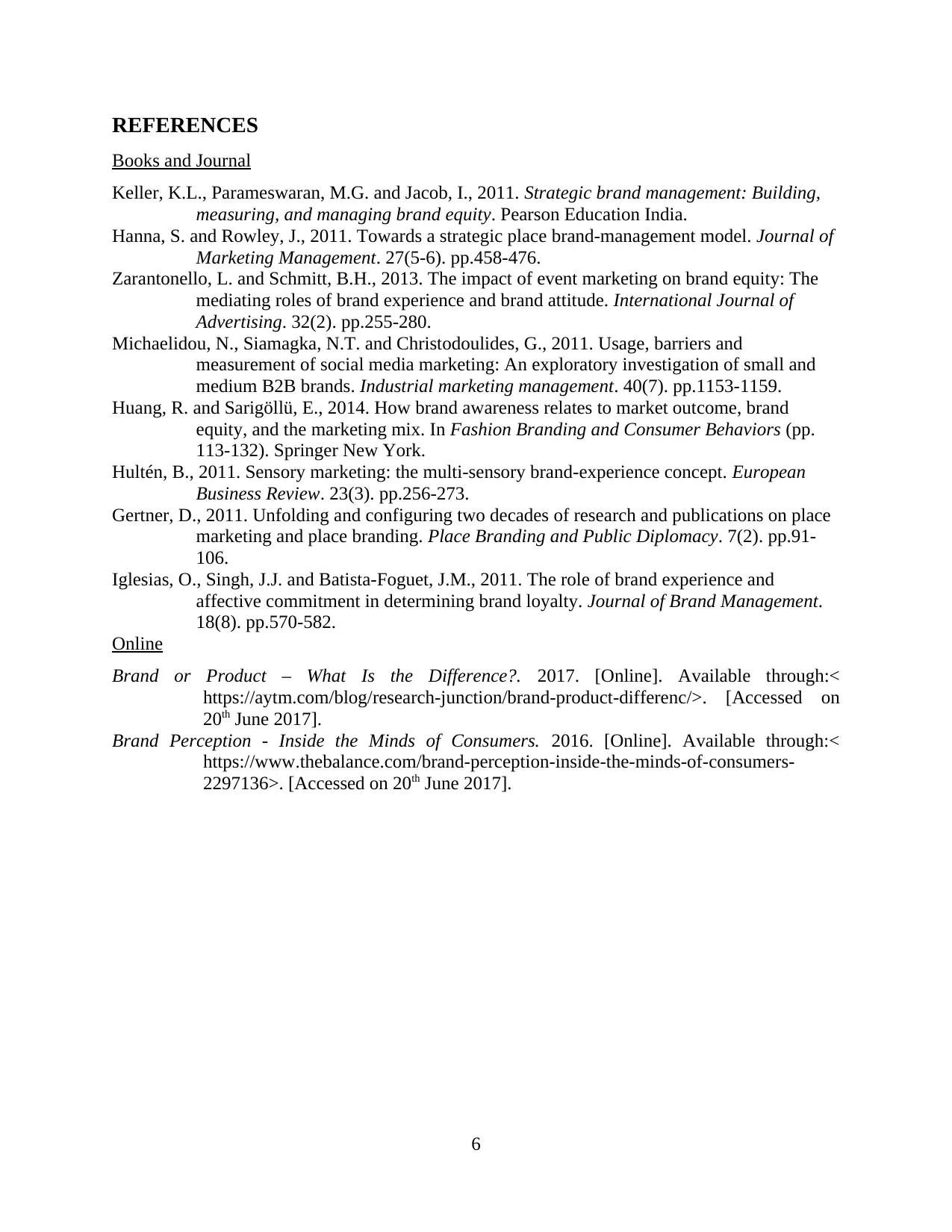
REFERENCES
Books and Journal
Keller, K.L., Parameswaran, M.G. and Jacob, I., 2011. Strategic brand management: Building,
measuring, and managing brand equity. Pearson Education India.
Hanna, S. and Rowley, J., 2011. Towards a strategic place brand-management model. Journal of
Marketing Management. 27(5-6). pp.458-476.
Zarantonello, L. and Schmitt, B.H., 2013. The impact of event marketing on brand equity: The
mediating roles of brand experience and brand attitude. International Journal of
Advertising. 32(2). pp.255-280.
Michaelidou, N., Siamagka, N.T. and Christodoulides, G., 2011. Usage, barriers and
measurement of social media marketing: An exploratory investigation of small and
medium B2B brands. Industrial marketing management. 40(7). pp.1153-1159.
Huang, R. and Sarigöllü, E., 2014. How brand awareness relates to market outcome, brand
equity, and the marketing mix. In Fashion Branding and Consumer Behaviors (pp.
113-132). Springer New York.
Hultén, B., 2011. Sensory marketing: the multi-sensory brand-experience concept. European
Business Review. 23(3). pp.256-273.
Gertner, D., 2011. Unfolding and configuring two decades of research and publications on place
marketing and place branding. Place Branding and Public Diplomacy. 7(2). pp.91-
106.
Iglesias, O., Singh, J.J. and Batista-Foguet, J.M., 2011. The role of brand experience and
affective commitment in determining brand loyalty. Journal of Brand Management.
18(8). pp.570-582.
Online
Brand or Product – What Is the Difference?. 2017. [Online]. Available through:<
https://aytm.com/blog/research-junction/brand-product-differenc/>. [Accessed on
20th June 2017].
Brand Perception - Inside the Minds of Consumers. 2016. [Online]. Available through:<
https://www.thebalance.com/brand-perception-inside-the-minds-of-consumers-
2297136>. [Accessed on 20th June 2017].
6
Books and Journal
Keller, K.L., Parameswaran, M.G. and Jacob, I., 2011. Strategic brand management: Building,
measuring, and managing brand equity. Pearson Education India.
Hanna, S. and Rowley, J., 2011. Towards a strategic place brand-management model. Journal of
Marketing Management. 27(5-6). pp.458-476.
Zarantonello, L. and Schmitt, B.H., 2013. The impact of event marketing on brand equity: The
mediating roles of brand experience and brand attitude. International Journal of
Advertising. 32(2). pp.255-280.
Michaelidou, N., Siamagka, N.T. and Christodoulides, G., 2011. Usage, barriers and
measurement of social media marketing: An exploratory investigation of small and
medium B2B brands. Industrial marketing management. 40(7). pp.1153-1159.
Huang, R. and Sarigöllü, E., 2014. How brand awareness relates to market outcome, brand
equity, and the marketing mix. In Fashion Branding and Consumer Behaviors (pp.
113-132). Springer New York.
Hultén, B., 2011. Sensory marketing: the multi-sensory brand-experience concept. European
Business Review. 23(3). pp.256-273.
Gertner, D., 2011. Unfolding and configuring two decades of research and publications on place
marketing and place branding. Place Branding and Public Diplomacy. 7(2). pp.91-
106.
Iglesias, O., Singh, J.J. and Batista-Foguet, J.M., 2011. The role of brand experience and
affective commitment in determining brand loyalty. Journal of Brand Management.
18(8). pp.570-582.
Online
Brand or Product – What Is the Difference?. 2017. [Online]. Available through:<
https://aytm.com/blog/research-junction/brand-product-differenc/>. [Accessed on
20th June 2017].
Brand Perception - Inside the Minds of Consumers. 2016. [Online]. Available through:<
https://www.thebalance.com/brand-perception-inside-the-minds-of-consumers-
2297136>. [Accessed on 20th June 2017].
6
1 out of 8
Related Documents
Your All-in-One AI-Powered Toolkit for Academic Success.
+13062052269
info@desklib.com
Available 24*7 on WhatsApp / Email
![[object Object]](/_next/static/media/star-bottom.7253800d.svg)
Unlock your academic potential
Copyright © 2020–2025 A2Z Services. All Rights Reserved. Developed and managed by ZUCOL.




